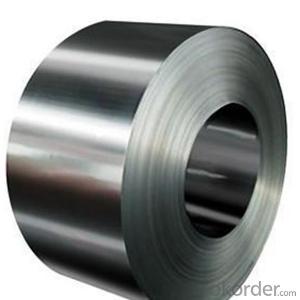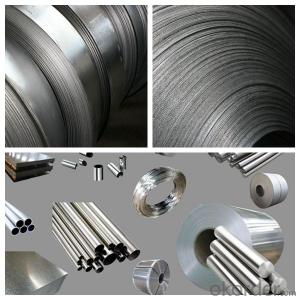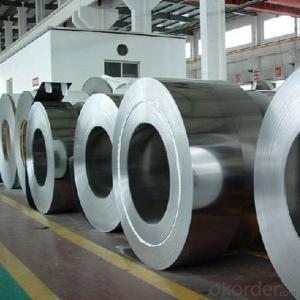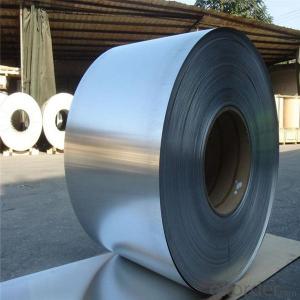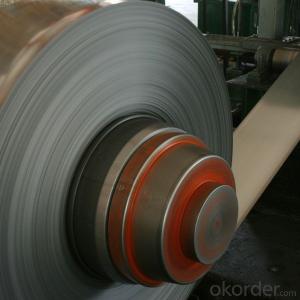Hot Rolled Stainless Steel 304 NO.1 Finish From China Supplier
- Loading Port:
- China main port
- Payment Terms:
- TT OR LC
- Min Order Qty:
- 22 m.t.
- Supply Capability:
- 1000 m.t./month
OKorder Service Pledge
OKorder Financial Service
You Might Also Like
Item specifice
Products Description for Stainless Steel Coils/Sheets:
Product | stainless steel coils/plates/sheets | ||
Discharge Port | Any Port, China | ||
Size | Coils | Cold Rolled: | Thickness0.3-8mm,Width:280-2100mm |
Hot Rolled : | Thickness3-14mm,Width:650-2100mm | ||
Plates | Thickness2-80mm,Width:1500-3000mm | ||
Coil Weight | About 20 Tons | ||
Grade | 201,202,304/304L/304H,316/316L/316H,321/H,310S,409/L,430 etc. | ||
Technique | Hot Rolled/Cold Rolled | ||
Finish | 2B, BA, 2D, No1, No2, No4,NO.8,SB etc | ||
Edge | Mill Edge / Slitting Edge | ||
Package | In bundles, or as customer's requirement | ||
Place of Origin | Made in China | ||
MOQ | 20 Tons | ||
Specifications for Stainless Steel Coils/Sheets:
Type | 200 series,300 series,400 series |
Thickness | 1.8-8.0mm |
Widthness | 1000/1219/1500mm |
Technique | Hot Rolled/Cold Rolled |
Coil Weight | About 20 Tons |
Finish | NO.1/NO.2B |
Place of Origin | Made in China |
MOQ | 18 ton |
Color | Black,Mirror Finished |
Standard | ASTM, JIS, GB, BS, DIN etc |
Exporting countries | Peru,India,Pakistan,Singpore,Vietnam,South Korea,Malaysia etc. |
After-sales service | Factory Inspection |
Certifications | ISO,SGS |
Packaging | Standard export packing or following customer's demand |
Features of Stainless Steel Coils
(1)Good ductility
(2)Good corrosion resistance
(3)Excellent abrasion resistance and fatigue strength
(4)Good weldability
(5)Oxidation resistant performance
(6)Excellent in high temperature
Payment&Delivery for Stainless Steel Coils/Sheets:
Payment Terms | 100% LC at sight,or 30%TT in advance, balance against B/L copy |
Delivery Time | With 30-40 days after deposit |
Price Terms | Ex-Work, FOB, CNF, CFR, CIF,etc |
Application of Stainless Steel Coils
(1)Boiler heat exchanger,
(2)Chemical industries,
(3)Hardware fields,
(4)Construction material,
(5)Kitchen utensils,
(6)Building construction,
(7)Medical equipment,
(8)Chemical tank,
(9)Pipe etc

- Q:What is the difference between stainless steel sheets and stainless steel plates?
- The main difference between stainless steel sheets and stainless steel plates lies in their thickness. Stainless steel sheets are typically thinner, with a thickness ranging from 0.4mm to 6mm, while stainless steel plates are thicker, with a thickness starting from 3mm and going up to several inches. Additionally, stainless steel plates are often used for structural purposes or heavy-duty applications, while stainless steel sheets are commonly used for decorative purposes, cladding, or smaller projects.
- Q:How do I prevent discoloration on stainless steel sheets?
- To avoid discoloration on stainless steel sheets, there are several steps you can take: 1. Keep them clean: Make sure to clean stainless steel sheets on a regular basis using mild soap or a dedicated stainless steel cleaner. Steer clear of abrasive cleaners or scrub brushes, as they can scratch the surface and make it more susceptible to discoloration. 2. Steer clear of harsh chemicals: Avoid using harsh chemicals, bleach, or cleaners containing chlorine on stainless steel sheets, as they can lead to discoloration. If any spills occur, clean them up immediately to prevent staining. 3. Ensure proper ventilation: It is crucial to have adequate ventilation in the area where the stainless steel sheets are installed. This is particularly important in spaces where chemicals or fumes are present, as they can react with the stainless steel and cause discoloration. 4. Apply protective coatings: Consider applying a protective coating to the stainless steel sheets to help prevent discoloration. There are various protective coatings available on the market that are specifically designed for stainless steel. These coatings create a barrier between the steel and external factors, reducing the likelihood of discoloration. 5. Perform regular maintenance: Regularly inspect the stainless steel sheets for any signs of discoloration or damage. Address any issues promptly to prevent further deterioration. By implementing these preventive measures, you can reduce the risk of discoloration on stainless steel sheets and maintain their aesthetic appeal for an extended period of time.
- Q:What is the area of stainless steel plate?
- First of all, I said, can not be sold by area, because the thickness of the price is not the same, I said the weight is how to draw, take SUS304 steel:Length (m) * width (mm) * thickness (mm) * density (7.93) /1000= weight
- Q:What are stainless steel sheets used for?
- Stainless steel sheets serve a multitude of purposes in diverse industries. Their outstanding resistance to corrosion, durability, and attractive appearance make them highly sought after in both commercial and residential settings. Within the construction field, these sheets are utilized for roofing, cladding, and facades due to their ability to withstand harsh environmental conditions while providing a contemporary and sleek look. In the automotive industry, they are frequently employed in the construction of car bodies, exhaust systems, and decorative trims. Furthermore, stainless steel sheets find extensive use in the food and beverage sector, where their hygienic qualities make them ideal for kitchen equipment, countertops, and food processing machinery. Additionally, they are widely used in medical equipment, pharmaceuticals, and laboratory settings due to their resistance to corrosion and ease of cleaning. They are also employed in furniture, appliances, signage, and for decorative purposes, as they can be easily customized and molded into various shapes and sizes. All in all, stainless steel sheets are an adaptable material that fulfills a diverse array of requirements in different industries, owing to their strength, durability, and corrosion resistance properties.
- Q:How do I prevent rusting on stainless steel sheets?
- To prevent rusting on stainless steel sheets, there are several steps you can take: 1. Keep the surface clean: Regularly clean the stainless steel sheets using a mild detergent or stainless steel cleaner. This will help remove any dirt, grime, or contaminants that could lead to corrosion. 2. Avoid abrasive cleaners: Avoid using harsh or abrasive cleaners, as they can scratch the surface of the stainless steel, making it more susceptible to rusting. Stick to non-abrasive cleaning solutions and soft cloths or sponges. 3. Remove rust promptly: If you notice any signs of rust on the stainless steel sheets, it is important to address it immediately. Use a stainless steel cleaner or a mixture of vinegar and water to gently remove the rust. Rinse thoroughly and dry the surface afterwards. 4. Protect against moisture: Stainless steel is resistant to rust, but it can still corrode in the presence of moisture. To prevent this, ensure that the stainless steel sheets are properly installed and sealed to protect against water or moisture infiltration. Avoid leaving standing water on the surface and promptly dry any spills or moisture. 5. Apply a protective coating: Consider applying a protective coating to the stainless steel sheets to provide an extra layer of protection against rust. There are various sealants and coatings available specifically designed for stainless steel that can help prevent corrosion. 6. Regular maintenance: Regularly inspect the stainless steel sheets for any signs of damage, rust, or corrosion. Address any issues promptly to prevent further damage. Additionally, perform routine cleaning and maintenance to keep the surface in optimal condition. By following these preventive measures, you can significantly reduce the chances of rusting on stainless steel sheets and maintain their longevity and aesthetic appeal.
- Q:Can stainless steel sheets be used for elevator panels?
- Indeed, elevator panels can make use of stainless steel sheets. Stainless steel, being highly durable, strong, and visually appealing, is a favored material for elevator panels. Its resistance to corrosion, damage, and wear makes it ideal for high-traffic regions such as elevators. Furthermore, stainless steel panels are effortless to clean and maintain, which is crucial for preserving a pristine and polished appearance within elevators. Moreover, stainless steel can be easily tailored and manufactured to suit precise elevator dimensions and design necessities. All in all, stainless steel sheets represent a dependable and adaptable choice for elevator panels.
- Q:Are stainless steel sheets suitable for escalator claddings?
- Indeed, escalator claddings can be effectively adorned with stainless steel sheets. With its durability and resistance to corrosion, stainless steel emerges as an exceptional option for heavily frequented zones such as escalators. Moreover, its effortless cleaning and maintenance are of utmost significance in public areas. Furthermore, stainless steel's sleek and contemporary appearance has the potential to elevate the overall aesthetic of the escalator.
- Q:How do you calculate the bending radius for stainless steel sheets?
- To calculate the bending radius for stainless steel sheets, you need to consider the material's thickness, tensile strength, and the desired level of bendability. The bending radius can be determined using formulas or tables specific to stainless steel, taking into account these factors to ensure the sheet does not crack or deform during bending.
- Q:What are the common uses of stainless steel sheets in the automotive industry?
- Stainless steel sheets are commonly used in the automotive industry for various purposes such as manufacturing body panels, exhaust systems, fuel tanks, and decorative trim. The corrosion-resistant properties of stainless steel make it an ideal material for these applications, providing durability and aesthetic appeal to vehicles.
- Q:Can stainless steel sheets be used for walkways and platforms?
- Stainless steel sheets are capable of being utilized for walkways and platforms. This material, known for its exceptional durability and resistance to corrosion, proves to be ideal for outdoor applications such as walkways and platforms. It has the capacity to endure substantial loads, severe weather conditions, and frequent foot traffic, all while avoiding deterioration and rusting. Moreover, stainless steel possesses a sleek and contemporary appearance that can elevate the visual allure of walkways and platforms. Furthermore, it boasts easy cleaning and maintenance processes, guaranteeing extended lifespan and safety for users.
1. Manufacturer Overview |
|
|---|---|
| Location | |
| Year Established | |
| Annual Output Value | |
| Main Markets | |
| Company Certifications | |
2. Manufacturer Certificates |
|
|---|---|
| a) Certification Name | |
| Range | |
| Reference | |
| Validity Period | |
3. Manufacturer Capability |
|
|---|---|
| a)Trade Capacity | |
| Nearest Port | |
| Export Percentage | |
| No.of Employees in Trade Department | |
| Language Spoken: | |
| b)Factory Information | |
| Factory Size: | |
| No. of Production Lines | |
| Contract Manufacturing | |
| Product Price Range | |
Send your message to us
Hot Rolled Stainless Steel 304 NO.1 Finish From China Supplier
- Loading Port:
- China main port
- Payment Terms:
- TT OR LC
- Min Order Qty:
- 22 m.t.
- Supply Capability:
- 1000 m.t./month
OKorder Service Pledge
OKorder Financial Service
Similar products
New products
Hot products
Hot Searches
Related keywords

